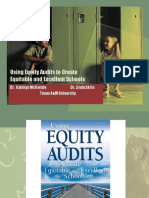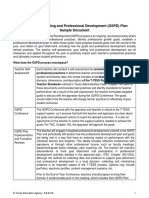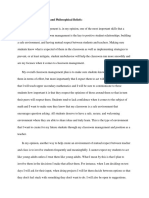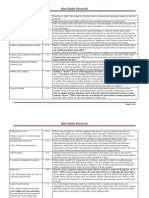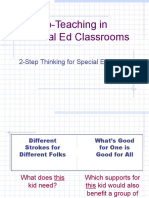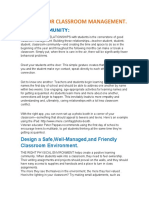0 ratings0% found this document useful (0 votes)
1K viewsFrisk Training
Frisk Training
Uploaded by
api-369701573This document provides guidance on using the FRISK model for employee performance improvement and documentation. FRISK stands for Facts, Rule, Impact, Suggestions/Directions for Improvement, and Knowledge. It describes using FRISK to communicate with employees about performance issues, provide suggestions for improvement, and create legally sufficient documentation that can be used in disciplinary cases if needed. It also provides examples of using the FRISK framework and describes when it should be applied in the progressive discipline process.
Copyright:
© All Rights Reserved
Available Formats
Download as PPT, PDF, TXT or read online from Scribd
Frisk Training
Frisk Training
Uploaded by
api-3697015730 ratings0% found this document useful (0 votes)
1K views42 pagesThis document provides guidance on using the FRISK model for employee performance improvement and documentation. FRISK stands for Facts, Rule, Impact, Suggestions/Directions for Improvement, and Knowledge. It describes using FRISK to communicate with employees about performance issues, provide suggestions for improvement, and create legally sufficient documentation that can be used in disciplinary cases if needed. It also provides examples of using the FRISK framework and describes when it should be applied in the progressive discipline process.
Original Title
frisk training
Copyright
© © All Rights Reserved
Available Formats
PPT, PDF, TXT or read online from Scribd
Share this document
Did you find this document useful?
Is this content inappropriate?
This document provides guidance on using the FRISK model for employee performance improvement and documentation. FRISK stands for Facts, Rule, Impact, Suggestions/Directions for Improvement, and Knowledge. It describes using FRISK to communicate with employees about performance issues, provide suggestions for improvement, and create legally sufficient documentation that can be used in disciplinary cases if needed. It also provides examples of using the FRISK framework and describes when it should be applied in the progressive discipline process.
Copyright:
© All Rights Reserved
Available Formats
Download as PPT, PDF, TXT or read online from Scribd
Download as ppt, pdf, or txt
0 ratings0% found this document useful (0 votes)
1K views42 pagesFrisk Training
Frisk Training
Uploaded by
api-369701573This document provides guidance on using the FRISK model for employee performance improvement and documentation. FRISK stands for Facts, Rule, Impact, Suggestions/Directions for Improvement, and Knowledge. It describes using FRISK to communicate with employees about performance issues, provide suggestions for improvement, and create legally sufficient documentation that can be used in disciplinary cases if needed. It also provides examples of using the FRISK framework and describes when it should be applied in the progressive discipline process.
Copyright:
© All Rights Reserved
Available Formats
Download as PPT, PDF, TXT or read online from Scribd
Download as ppt, pdf, or txt
You are on page 1of 42
FRISK TRAINING
PLNU SCHOOL OF EDUCATION
GEL 607
PROFESSIONAL LEARNING AND GROWTH LEADERSHIP
WHY FRISK?
• The FRISK model was developed by Steven J.
Andelson of Atkinson, Andelson, Loya, Ruud &
Romo.
● The main purpose of the FRISK model is to
improve employee performance through
direct, honest, and constructive communication.
WHY FRISK?
• However, if the employee does not improve and,
as a last resort, disciplinary action is necessary,
the model includes the elements for legally
sufficient documentation. It is our primary
source of evidence to support management’s
burden of proof in disciplinary cases.
FRISK
F= Facts
R= Rule
I= Impact
S= Suggestions/Directions for Improvement
K= Knowledge
FRISK
F (Fact) What did the employee do?
R (Rule) What should the employee have done?
I (Impact) What was the impact or possible impact of the
employee’s conduct on the district?
S (Suggestion) When and what do you want the employee
to do to improve performance in the future? What will
happen if there is no improvement?
K (Knowledge) Does the employee have knowledge of
personnel file rights required by Education Code Section
44031, and applicable labor contract provisions?
WEINGARTEN RIGHTS
Remember….. before conducting an
investigatory conference with an employee
which could result in discipline, inform the
employee of his right to representation at
the conference.
FACTS-
WHAT DID THE EMPLOYEE DO?
• Clearly pinpoint the specific conduct deemed
deficient.
• Describe the specific conduct in complete and
explicit terms avoiding unnecessary technical
language.
• Avoid factual errors
FACTS-
A principal having concerns about a teacher’s
incomplete lesson plan, inadequate assessment of
student work , and poor student control
SEPARATELY DESCRIBES AND
DOCUMENTS EACH PERFORMANCE
DEFICIENCY.
FACTS - EXAMPLE
Incomplete lesson plans-
“Your lesson plans that I reviewed on March 12,
2018 were incomplete. You did not provide
enough information for a substitute to continue
your planned curriculum. For example, several
periods were unplanned or lacked an identified
objective or learning level for a specific activity.”
FACTS - EXAMPLE
Inadequate assessment of student work-
“You have not assessed students’ performance and achievement
with well-defined criteria. For example, on April 6, 2018, you gave
your 7th grade students an essay test. Several students received a
grade of D; however, you did not support the grade with detailed
analysis. You merely remarked the essays were ‘not very
interesting.”
FACTS - EXAMPLE
Poor student control-
“During a classroom observation on February 27,
2018, while reviewing a grammar quiz, you failed
to maintain control of your class. For example,
four students were passing notes to each other
and laughing, two students were openly texting
on their cell phones, and three students were
throwing erasers.”
RULE-
WHAT SHOULD THE EMPLOYEE HAVE DONE?
The “rule” represents the standard, authority, direction,
mandate or expectation that the employee is required to follow.
• District Policies or Administrative Regulations
• Collective bargaining agreement (contract)
• Job descriptions
• Employee handbook
• Adopted Curriculum Standards
• Prior Administrative announcements
• Generally accepted practice or expectation
IMPACT-
WHAT IS THE IMPACT OR POSSIBLE IMPACT OF THE
EMPLOYEE’S CONDUCT ON THE DISTRICT?
“Impact” is important to establish the
CONNECTION between the employee’s deficient
conduct and its negative impact on the school
district-which may involve students, employees,
parents or property.
IMPACT-
As a general rule, in documenting the negative
impact of unsatisfactory employee performance,
the evaluator should state facts which show:
• Adverse impact or possible adverse impact of the employees
conduct on the efficient operations of the district, school, and/or
educational process.
• Adverse impact or possible adverse impact of the employees
conduct on students, other employees and/or parents.
• The degree of public notoriety resulting from the employee’s
conduct that impairs or is likely to impair the employee’s
effectiveness to do the job.
IMPACT-EXAMPLE
Example 1: “Your failure to provide supervision
during your scheduled yard duty and bus duty
assignments has resulted in injury to students
involved in a scuffle in your supervision area.”
Example 2: “Your belligerent attitude toward
students as reflected in your sarcastic and
demeaning notes and rude comments during
class have had an adverse impact on your
teaching effectiveness, which has resulted in
student and parent complaints.”
SUGGESTIONS/DIRECTIVES-
WHAT SHOULD THE EMPLOYEE DO TO IMPROVE PERFORMANCE?
• You have previously told the employee what
happened and what should have happened,
and you have connected the employee’s
conduct to the job.
• Now you are identifying what must be done to
correct the employee’s deficient performance
and are providing suggestions/offers of
assistance for improvement.
SUGGESTIONS/DIRECTIVES-WHAT
SHOULD THE EMPLOYEE DO TO IMPROVE
PERFORMANCE?
• Provide directions on proper conduct or level of
performance expected to be followed in the future;
and
• Provide suggestions, recommendations, or directives
to assist employees in meeting these requirements.
SUGGESTIONS/DIRECTIVES-
DRAFTING CLEAR COMMANDS
• The test for determining a clear and unequivocal
command is that it must not leave room for the
employee’s own interpretation.
• A statement that implicitly gives an employee the
option of not obeying is not a clear and unequivocal
command.
SUGGESTIONS/DIRECTIVES
Examples-
“Effective immediately, you will fulfill your
responsibility of providing supervision as assigned on
the duty schedule. To assist you with this, I will
provide an additional copy of the supervision duty
schedule and will personally review it with you.”
SUGGESTIONS/DIRECTIVES
Example-
“Effective immediately, you will maintain proper control in
your classroom ensuring that all students are engaged in
learning and free from distractions. To assist you with this, I
will provide release time with a coach who will work with you
on classroom management strategies. Additionally, I will make
more frequent visits to your classroom to observe your
classroom setting and to ensure that you are following this
directive.”
KNOWLEDGE
• Does employee have knowledge of document
(letter of reprimand, conference summary, etc.)
being placed in personnel file?
• Employee should be informed of right to add a
response which should be attached to the letter.
KNOWLEDGE
Example-
•“A copy of this letter will be placed in your
personnel file after 10 days. You may prepare a
response which will be attached to this letter.”
•(To be initialed by employee)
“I acknowledge receipt of a copy of this letter on
________.”
WHEN TO DOCUMENT
The FRISK model can be used for various types of
documents to record unsatisfactory employee
performance including. The type of document should
be determined by the following progressive discipline
process guide:
• oral warning/conference summary
• written warning
• letter of reprimand
• unsatisfactory evaluation
• suspension without pay
• dismissal
WHEN TO DOCUMENT
As a general rule, when uncertain as to which
progressive discipline step to apply, confer with
your HR Director.
RULES REGARDING
INVESTIGATIONS
• Weingarten
In 1975, the United States Supreme Court in the
case of NLRB v. J. Weingarten, Inc. 420 U.S. 251
(1975) upheld a National Labor Relations Board
(NLRB) decision that employees have a right to
union representation at investigatory interviews
These rights have become known as the
Weingarten Rights.
CONFERENCES
• Employees are entitled to representation at
investigatory meetings.
• Your FRISK conference, where the FRISK
document is presented to the employee, will be
conducted in a separate meeting following your
investigatory meeting.
• Again, these should be separate!
SCENARIO 1
• The following scenario will take you through the
FRISK steps and represents how a document,
such as a conference summary, would be
developed.
• This is what follows a meeting or investigation.
• These scenarios are based upon actual incidents.
SCENARIO: FACT
It was reported to me and confirmed by you that,
during the past week, you placed a mousetrap in the
candy dish on your desk in an attempt to “catch” the
student or students responsible for stealing candy
from your candy dish.
SCENARIO: RULE
Staff and students are not permitted to
bring mousetraps into the classroom or
anywhere on the school site.
You are expected to maintain a safe
classroom environment.
SCENARIO: IMPACT
• Your actions could have resulted in injury
to a student or fellow staff member.
• Furthermore, your actions could have
resulted in legal action against you and the
District.
• Your actions could have resulted in
negative publicity to the District.
SCENARIO:
SUGGESTION/DIRECTIVE
• You are directed to maintain a safe and orderly
classroom free from dangerous objects and
weapons.
• You are directed to consult administration when
you need assistance in dealing with student
discipline issues.
SCENARIO:
KNOWLEDGE
• A copy of this letter will be placed in your
personnel file after ten days.
• You may file a response which will be attached to
this letter.
SCENARIO 2
• The following scenario took place at an
elementary school site.
SCENARIO 2: FACT
A student reported the following:
You have regularly brought your personal laptop
computer to school and worked from it at your
desk. Tabs on your computer were visible to
students and read, “Free Porn,” “Live Chat,” “Sex
Show,” and “Hidden Camera.”
SCENARIO 2: FACT -
CONTINUED
An investigation was conducted and the findings
support this allegation. During the investigation, you
denied visiting the named internet sites. You stated
your District issued device was not working so you
brought your personal laptop from home to work
from.
SCENARIO 2: RULE
• The normal procedure for addressing instructional
technology needs is to report it to your
administrator.
• Viewing porn while on duty at work and in the
presence of children is inappropriate and potentially
criminal.
• This behavior violates board policy on professional
conduct.
SCENARIO 2: IMPACT-
This activity conducted during instructional time impacted
students, staff, and parents inasmuch as:
1. Students were deprived of valuable instruction and
supervision,
2. Parents and administration have cause to question your
character and ability to carry out the duties of a teacher,
3. You potentially brought unwanted notoriety and liability
to the District.
SCENARIO 2:
SUGGESTIONS/DIRECTIVES
1. Review the Districts Acceptable User Policy.
2. Report any instructional technology needs to your site
administrator.
3. Do not bring your personal laptop computer from home
for any reason.
4. Maximize your use of instructional time.
5. Conduct yourself in a professional manner at all times.
SCENARIO 2: KNOWLEDGE
A copy of this document will be placed in your
personnel file after 10 days.
You may prepare a response which will be attached
to this document.
Your signature acknowledges receipt of this
document.
SITE FILES
Site files concerning an employee’s performance are typically
kept to:
• Make record of oral warnings
• Preserve written warnings/conference summaries
• Record preliminary information
• Hold complaints filed against an employee pending an
investigation and disposition
FRISK TEMPLATES:
Use the FRISK model for:
• conference summaries
• warning letters
Work with your HR Director when employee
discipline rises to the level of letters of reprimand.
SCENARIOS
• You will be provided a scenario which requires an
intervention from you, the site principal.
• Using the steps of the FRISK process, write up a conference
summary.
• Conduct a conference with your employee.
You might also like
- Luiselli, Valeria - Tell Me How It Ends. An Essay PDFDocument76 pagesLuiselli, Valeria - Tell Me How It Ends. An Essay PDFolivia6teroba-136% (11)
- Laws of The State of Maine Passed by 131st LegislatureDocument1,262 pagesLaws of The State of Maine Passed by 131st LegislatureNEWS CENTER MaineNo ratings yet
- Kymlicka - Contemporary Political PhilosophyDocument510 pagesKymlicka - Contemporary Political PhilosophyAda Chiu100% (3)
- Trish Hatch - The Use of Data in School Counseling - Hatching Results For Students, Programs, and The Profession-Corwin (2013)Document535 pagesTrish Hatch - The Use of Data in School Counseling - Hatching Results For Students, Programs, and The Profession-Corwin (2013)Ria ReyNo ratings yet
- Using Equity Audits To Create Equitable and ExcellentDocument46 pagesUsing Equity Audits To Create Equitable and ExcellentAce007DNo ratings yet
- GSPD Sample DocumentDocument5 pagesGSPD Sample DocumentAirah Santiago100% (1)
- Classroom Management Plan TemplateDocument4 pagesClassroom Management Plan TemplateCrisnelyn0% (1)
- Itroduction To Legal English UNIT 1Document12 pagesItroduction To Legal English UNIT 1Andrei EniNo ratings yet
- Danielson Facilitators GuideDocument4 pagesDanielson Facilitators GuideJulian A.No ratings yet
- Classroom Management PlanDocument3 pagesClassroom Management PlankatieNo ratings yet
- Smart Card Color 20140819Document1 pageSmart Card Color 20140819api-262692272No ratings yet
- GANAG Lesson Plan Template BlankDocument1 pageGANAG Lesson Plan Template BlankPaula AyalaNo ratings yet
- Semi Detailed Lesson Plan in Epp VLDocument5 pagesSemi Detailed Lesson Plan in Epp VLMei Bhern Garo67% (3)
- Learning and Teaching: Submitted by Annie Terrence B.ed First Year Department of ENGLISHDocument16 pagesLearning and Teaching: Submitted by Annie Terrence B.ed First Year Department of ENGLISHAnnie TerrenceNo ratings yet
- TeacherLeadership TeacherSelf-Assessment WordDocument36 pagesTeacherLeadership TeacherSelf-Assessment Wordjennifer VenturiNo ratings yet
- Maximizing Student Learning With Flexible GroupingDocument4 pagesMaximizing Student Learning With Flexible Groupingapi-291864717No ratings yet
- Classroom Management PlanDocument8 pagesClassroom Management PlanT.j. Miller100% (1)
- Success Criteria TemplateDocument4 pagesSuccess Criteria TemplateShruthiNo ratings yet
- Small Group InstructionDocument8 pagesSmall Group InstructiontetestNo ratings yet
- DI Educators Guide - Print PDFDocument61 pagesDI Educators Guide - Print PDFioana calugareanuNo ratings yet
- JRMS Student OrientationDocument36 pagesJRMS Student OrientationZo LianNo ratings yet
- Drago-Severson Article 12 14Document5 pagesDrago-Severson Article 12 14api-362435059No ratings yet
- 90-Day Entry PlanDocument13 pages90-Day Entry Planapi-558817903No ratings yet
- Education Capstone - Danielson Framework For TeachingDocument14 pagesEducation Capstone - Danielson Framework For Teachingapi-530119088No ratings yet
- Sample Behavior District-Wide Evidence-Based Strategies 2fpractices For BehaviorDocument9 pagesSample Behavior District-Wide Evidence-Based Strategies 2fpractices For Behaviorapi-383588513100% (1)
- Positive Discipline - Guidelines PDFDocument2 pagesPositive Discipline - Guidelines PDFRocsaineNo ratings yet
- The School Principal As Leader Guiding Schools To Better Teaching and Learning 2nd EdDocument28 pagesThe School Principal As Leader Guiding Schools To Better Teaching and Learning 2nd Edmanuel lacro jrNo ratings yet
- An Index of Teaching & Learning Strategies: 39 Effect Sizes in Ascending OrderDocument6 pagesAn Index of Teaching & Learning Strategies: 39 Effect Sizes in Ascending OrderterryheickNo ratings yet
- Teacher Professional Growth Plan 2014Document3 pagesTeacher Professional Growth Plan 2014api-238204144No ratings yet
- Reflective JournalsDocument4 pagesReflective Journalsapi-383942416No ratings yet
- Gaps and Needs Assessment Information PDFDocument22 pagesGaps and Needs Assessment Information PDFJonalyn ObinaNo ratings yet
- Embracing InquiryDocument12 pagesEmbracing InquiryMarissa T. LumacadNo ratings yet
- Test-Taking Strategies For The Staar Eoc TestDocument30 pagesTest-Taking Strategies For The Staar Eoc Testapi-2555419470% (1)
- Article of The WeekDocument7 pagesArticle of The Weekapi-547912397No ratings yet
- Alignment of Management Philosophy Theory PlanDocument8 pagesAlignment of Management Philosophy Theory Planapi-357949761No ratings yet
- Co-Teaching in General Ed Classrooms-1Document27 pagesCo-Teaching in General Ed Classrooms-1teachingfellows100% (1)
- Diane L. Ronis Brain Compatible Assessments Corwin Press 2007Document231 pagesDiane L. Ronis Brain Compatible Assessments Corwin Press 2007marie100% (1)
- Chapter4 - History of SPED LawDocument29 pagesChapter4 - History of SPED LawjecjocNo ratings yet
- Adult Ed Lesson PlansDocument21 pagesAdult Ed Lesson Plansapi-402782196No ratings yet
- Mtss Parent Explanation Letter 2015-16-Long VersionDocument2 pagesMtss Parent Explanation Letter 2015-16-Long Versionapi-110894488No ratings yet
- Ganag PresentationDocument67 pagesGanag PresentationPriscilla RuizNo ratings yet
- Megans Goals - Spring 2018Document3 pagesMegans Goals - Spring 2018api-321908127No ratings yet
- Aarsh Colleage Principal EvaluationDocument20 pagesAarsh Colleage Principal EvaluationArya SamajNo ratings yet
- Section 2 - WeeblyDocument13 pagesSection 2 - Weeblyapi-469406995No ratings yet
- 2 - Cognitive DevelopmentDocument17 pages2 - Cognitive DevelopmentCameron RiceNo ratings yet
- Christy Harrison Resume-Math SupportDocument2 pagesChristy Harrison Resume-Math Supportapi-502192673No ratings yet
- Kirkpatrick's Four Levels of Evaluation ModelDocument6 pagesKirkpatrick's Four Levels of Evaluation ModelArif Hossain AryanNo ratings yet
- Ten Tips For Classroom ManagementDocument5 pagesTen Tips For Classroom ManagementLízbeth GuillénNo ratings yet
- Explicit Instruction PDFDocument5 pagesExplicit Instruction PDFChadweck FidelinoNo ratings yet
- IEP Meeting Workbook Lead MagnetDocument18 pagesIEP Meeting Workbook Lead MagnetGayathri sundarajan100% (1)
- RPIDocument7 pagesRPIurusetiaNo ratings yet
- Assertive DisciplineDocument18 pagesAssertive DisciplineCelynn Claire100% (1)
- Amherst-Pelham Regional Public Schools: Supporting and Retaining School LeadersDocument10 pagesAmherst-Pelham Regional Public Schools: Supporting and Retaining School LeadersHeather MorrisonNo ratings yet
- MLP Learning Paper Pdmes Preparation rt3 EseaDocument25 pagesMLP Learning Paper Pdmes Preparation rt3 Eseaapi-198801434No ratings yet
- All Lesson Plans and RefelctionsDocument24 pagesAll Lesson Plans and Refelctionsapi-300212612No ratings yet
- T-TESS Appraiser Sample Conferencing QuesionsDocument4 pagesT-TESS Appraiser Sample Conferencing QuesionsAndrea BrownleeNo ratings yet
- DDDM PG 092909 PDFDocument76 pagesDDDM PG 092909 PDFvigneshmahamuni100% (1)
- Epstein's Six Types of Parent InvolvementDocument1 pageEpstein's Six Types of Parent InvolvementMichael Joseph Dela CruzNo ratings yet
- Principals Set Goals For New School Year and PD TipsDocument9 pagesPrincipals Set Goals For New School Year and PD Tipsamin jamalNo ratings yet
- TDSB Effective Practices For Providers of Professional Learning and Training FinalDocument14 pagesTDSB Effective Practices For Providers of Professional Learning and Training FinalmattwebbeNo ratings yet
- Reinforcement Schedule WorksheetDocument1 pageReinforcement Schedule Worksheetapi-3271406580% (1)
- Assessment Matters Assignment Week 5Document6 pagesAssessment Matters Assignment Week 5api-266497495No ratings yet
- Family Engagement SurveyDocument49 pagesFamily Engagement SurveyReynalyn Pelaez MatiningNo ratings yet
- Operations Management: Course Syllabus OPMG-UB.0001.03Document16 pagesOperations Management: Course Syllabus OPMG-UB.0001.03maheritaniNo ratings yet
- A Level Coursework GuidanceDocument4 pagesA Level Coursework GuidanceanthealdNo ratings yet
- Teacher Eval-2Document3 pagesTeacher Eval-2api-369701573No ratings yet
- Sample LettersDocument3 pagesSample Lettersapi-369701573No ratings yet
- CollectiveDocument6 pagesCollectiveapi-369701573No ratings yet
- ScenariosDocument2 pagesScenariosapi-369701573No ratings yet
- LearningDocument15 pagesLearningapi-369701573No ratings yet
- Hard ConversationsDocument16 pagesHard Conversationsapi-369701573100% (1)
- Assignment 5 Improvement PlanDocument1 pageAssignment 5 Improvement Planapi-369701573No ratings yet
- p21 k-12 Global Ed IndicatorsDocument55 pagesp21 k-12 Global Ed Indicatorsapi-328107029100% (1)
- Genentech LawsuitDocument30 pagesGenentech Lawsuitcme_privat100% (1)
- What Is A Compoundable and Non Compoundable Offence in IndiaDocument11 pagesWhat Is A Compoundable and Non Compoundable Offence in Indiadeepthiseran25598No ratings yet
- Grace Christian High School Vs LavanderaDocument3 pagesGrace Christian High School Vs LavanderaDora the ExplorerNo ratings yet
- Uber California Case - MSJ OrderDocument31 pagesUber California Case - MSJ OrderPrecognitoNo ratings yet
- Quarter 2-Week 3&4 Philippine Politics and GovernanceDocument31 pagesQuarter 2-Week 3&4 Philippine Politics and Governanceldsp.norlynletegioNo ratings yet
- Notes On Quasi OffensesDocument2 pagesNotes On Quasi Offenseskfv05No ratings yet
- CHE600028514Document1 pageCHE600028514naveenthamizan3062No ratings yet
- 556 l6 Breach of TrustDocument18 pages556 l6 Breach of TrustAttyynHazwaniNo ratings yet
- Authority of Solemnizing Officer Beso V DagumanDocument5 pagesAuthority of Solemnizing Officer Beso V DagumanRojas Law OfficeNo ratings yet
- Rem Digest 50-52 of Subject SyllabusDocument4 pagesRem Digest 50-52 of Subject SyllabusPaula BariuanNo ratings yet
- 2nd Sem PDFDocument507 pages2nd Sem PDFSaurabh Chauhan100% (1)
- Alegria v. DuqueDocument3 pagesAlegria v. DuqueLesly BriesNo ratings yet
- 15.deed of ExchangeDocument7 pages15.deed of ExchangeraguljbNo ratings yet
- AAA V Hon. Antonio CarbonellDocument3 pagesAAA V Hon. Antonio CarbonellTeresa CardinozaNo ratings yet
- 3-Local Legislative ProcessDocument33 pages3-Local Legislative ProcessGloria Lambo GillacoNo ratings yet
- Law and ReligionDocument8 pagesLaw and ReligionSergiu TheMajesticTricolorRoosterNo ratings yet
- Freehold Covenants Land Law - A SimplifiDocument3 pagesFreehold Covenants Land Law - A SimplifiHUi XinhuiNo ratings yet
- Investment Contract AgreementDocument8 pagesInvestment Contract Agreementdurbina.aalvarezNo ratings yet
- 848 - IX - Postigo v. Philippine Tuberculosis Society - 479 SCRA 628Document1 page848 - IX - Postigo v. Philippine Tuberculosis Society - 479 SCRA 628ianNo ratings yet
- IN RE: SUBPOENA ISSUED TO RICHARD J. HEFFLEY, Et Al. - Document No. 8Document2 pagesIN RE: SUBPOENA ISSUED TO RICHARD J. HEFFLEY, Et Al. - Document No. 8Justia.comNo ratings yet
- ScriptDocument6 pagesScriptMiguel CastilloNo ratings yet
- Progressive Development Corporation vs. Quezon City (1989)Document10 pagesProgressive Development Corporation vs. Quezon City (1989)Rad IsnaniNo ratings yet
- Sample FormatDocument7 pagesSample FormatVic CumpasNo ratings yet
- Canada Work Visa Eligibility Assessment FormDocument3 pagesCanada Work Visa Eligibility Assessment Formjorayan214No ratings yet
- Application Form UNMANNED AERIAL VEHICLES KJSB Indra PramuditaDocument3 pagesApplication Form UNMANNED AERIAL VEHICLES KJSB Indra PramuditapradityaNo ratings yet




